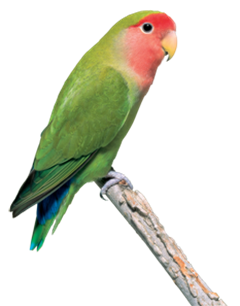Bird Care
Sitting on your finger
It is a real thrill when you first coax your bird to sit on your finger. Young birds can usually be trained quickly and easily to sit on your finger by following these guidelines.
To begin with, train your bird to step on to a piece of dowel or perch held in your hand before moving on to your finger. This gives your bird time to adjust to being outside the cage and having your hand up close and personal.
Take two pieces of dowel or two perches and hold one in front of your bird, just above the claws, then push gently against the body to encourage your bird to step on to the perch. When it steps on, do the same with the other perch. Repeat these steps until your bird steps on to any perch on offer.
Now substitute the perch with your finger and see how easily your bird will hop on to it. If he/she refuses to step on to your finger, carry on the training with the perches until it learns to do the trick. Remember, some birds take longer to step on to your finger, and this will also vary depending on its age and how tame it is before training begins.
Once your bird feels confident stepping on to your finger from the floor or a table, it is time to train it to step from one hand to the other. Do this slowly so as to give your bird the confidence to stay sitting on your finger and avoid lifting it too far off the ground until it feels secure on your hand.
Although these first training lessons can last for more than an hour, you do not need to always spend this amount of time. As a rule, it is better to teach your bird in short bursts such as three or four 10-minute lessons a day.
As with any kind of learning, the key to good training is routine and repetition so, for best results, conduct your training every day.
If the bird has gotten attached to one particular member of the family, now is a good time others to learn how to handle it. Remember, birds are fragile creatures and need gentle handling - so children should always be supervised when handling them.
